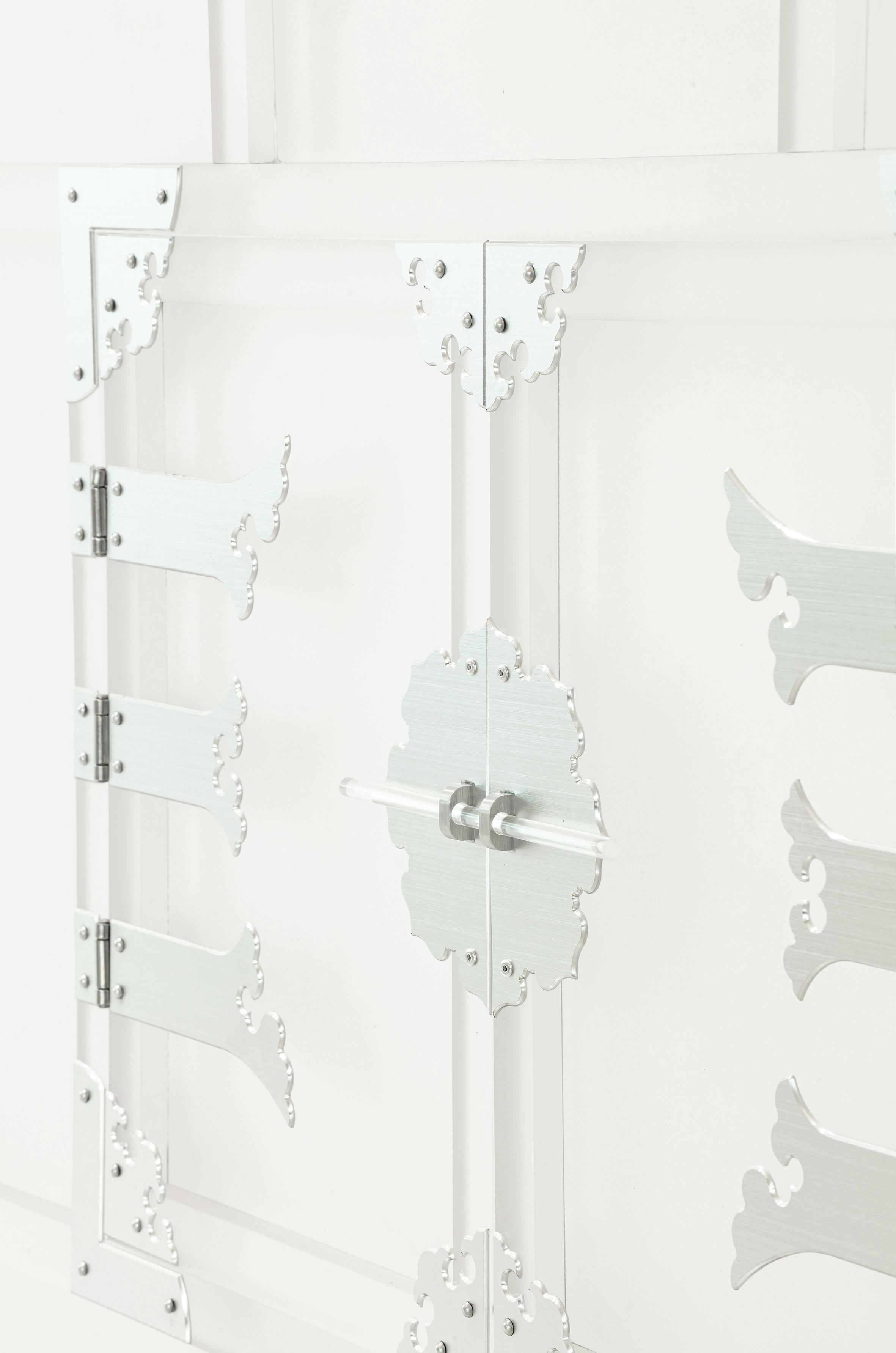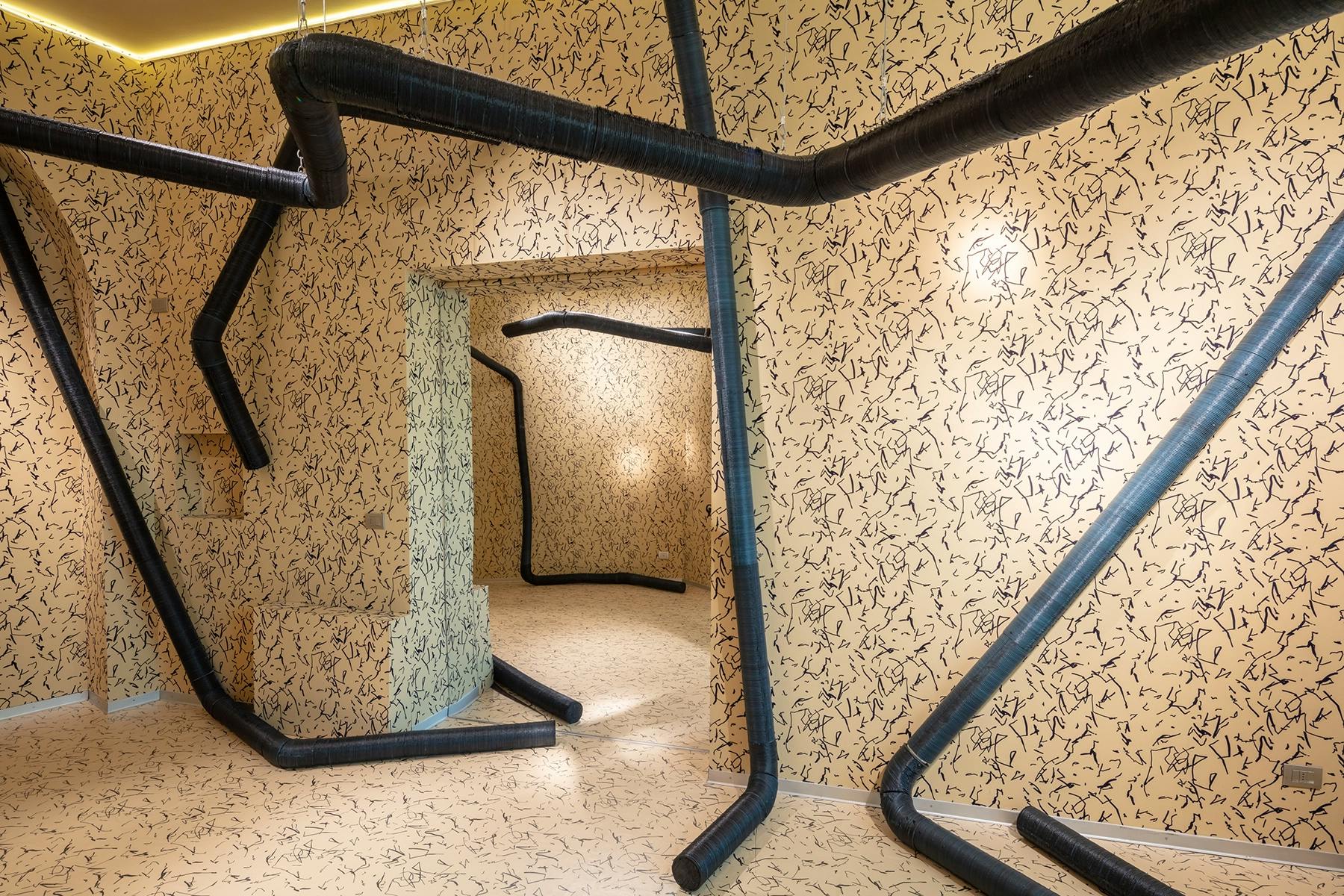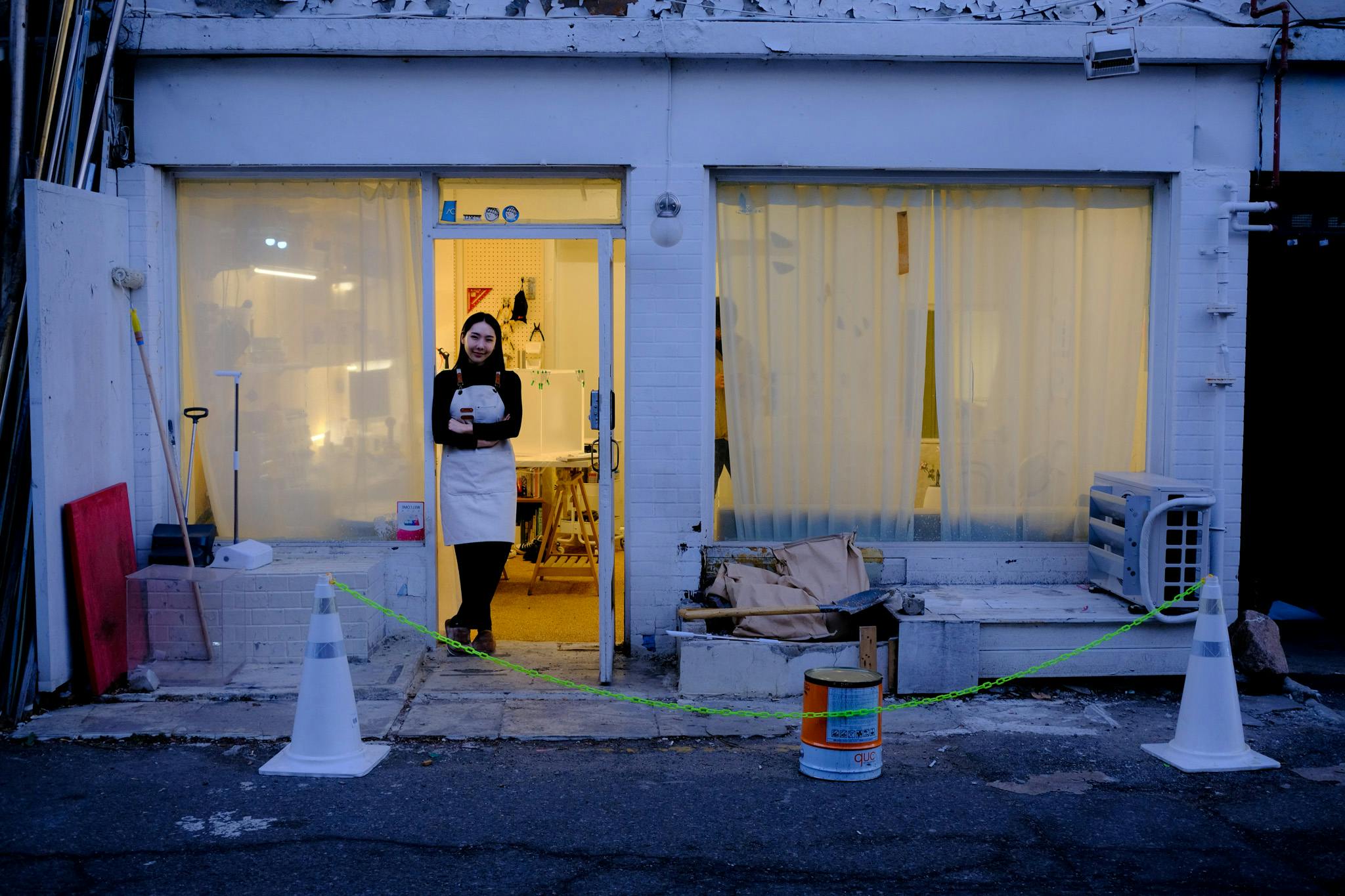
Studio Visit with Hyun-Hee Kim
We do a studio visit in Seoul, South Korea, with designer Hyun-Hee Kim, who borrows the form of traditional Korean furniture to record daily life in the modern era.
Walking through winding back alley streets on steeply undulating hills in the heart of Seoul's most diverse, creative and energetic neighbourhood of Itaewon led to the warmly lit studio space of furniture designer Hyun Hee Kim. After over a dozen visits to Seoul over the past few years, learning about the history and significance of specific objects and the delineation of space during the Joseon Dynasty, I was drawn to Hyun Hee's contemporary reinterpretations of traditional Korean furniture.
Decorative hardware imbued with meaning; transparent panels allow secrets hidden within the furniture to be revealed – Hyun Hee has an acute sensitivity to translating delicate histories of women, their role in society, experience with furniture and architecture and the future of it.
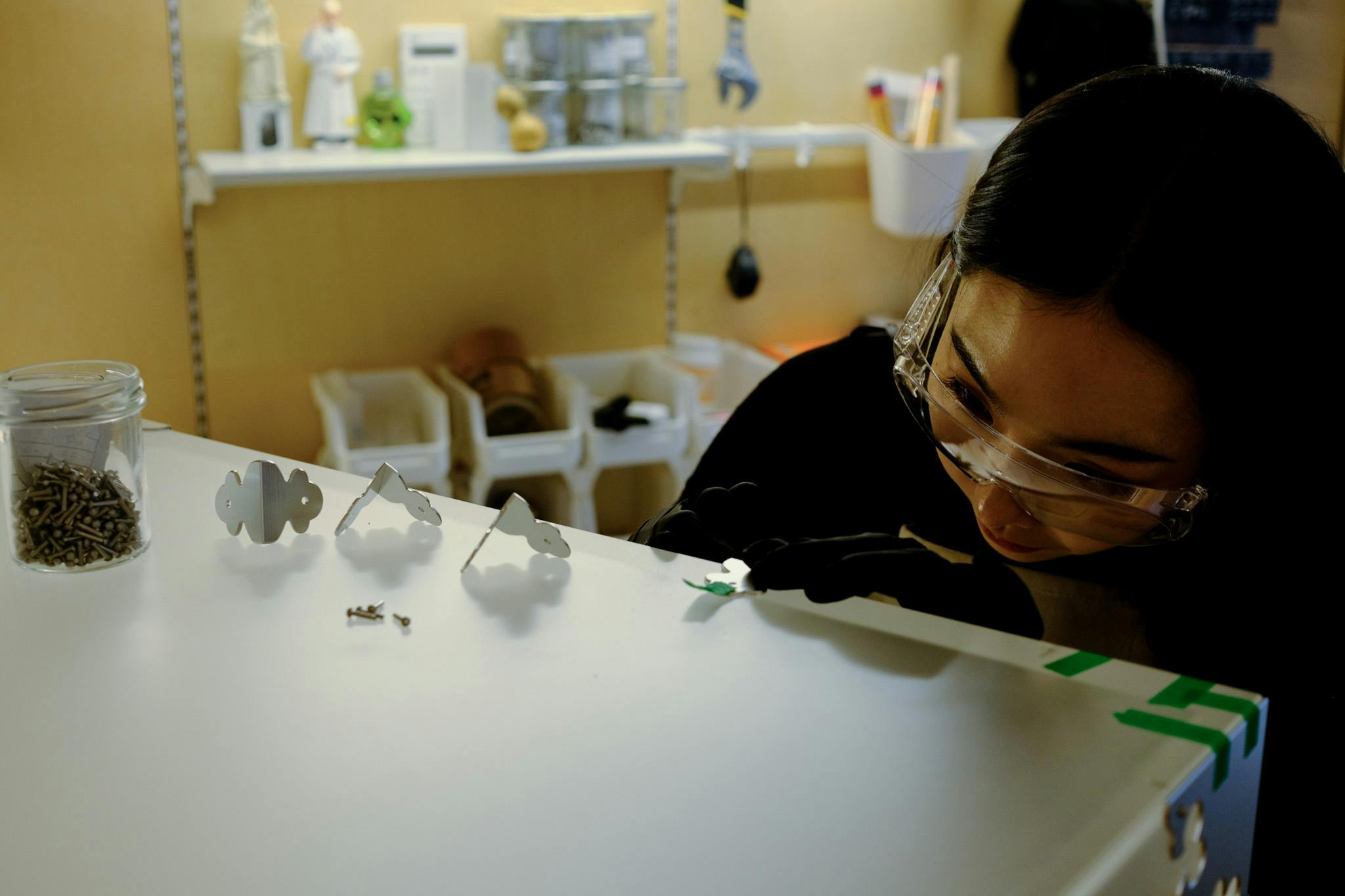
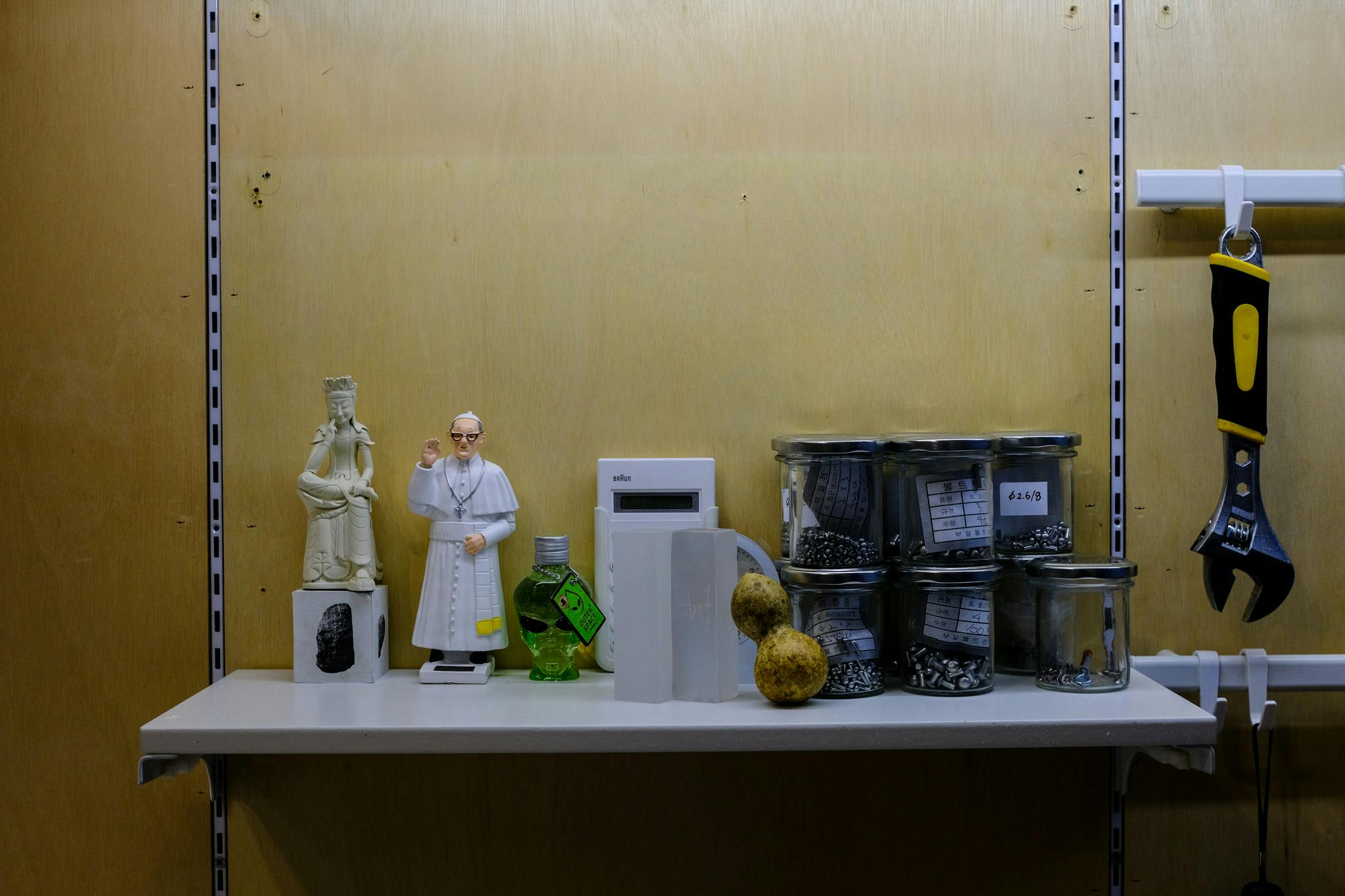
Kristen de la Vallière_ So, how did you get into furniture design?
그럼 어떻게 가구 디자인에 입문하게 됐나요?
Hyunhee_ I always enjoyed making things, but originally I wanted to do sculpture. I was more interested in conceptual work or putting stories into the physical work rather than just making aesthetically beautiful or practical furniture. I studied furniture design at Hongik University and learned from Byung Hoon Choi, who is also an art furniture artist. After this, the path came to me naturally.
저는 원래 홍익대학교에서 가구 디자인을 전공했었어요. 뭔가를 만드는 것도 좋아하고 익숙해져서 계속 하게 됐는데 저는 원래는 조각을 하고 싶었어요. 왜냐하면 그냥 미적으로 아름답거나 실용적인 가구를 만들려는 게 아니라 좀 더 스토리를 담아서 어떤 개념을 담는 작업을 가구에 하고 싶었는데, 제가 배웠던 선생님이 최병원 선생님이라고 아트퍼니처 하시는 분인데 그분께 수업을 배우다 보니까 그쪽으로 작업을 하게 됐죠.

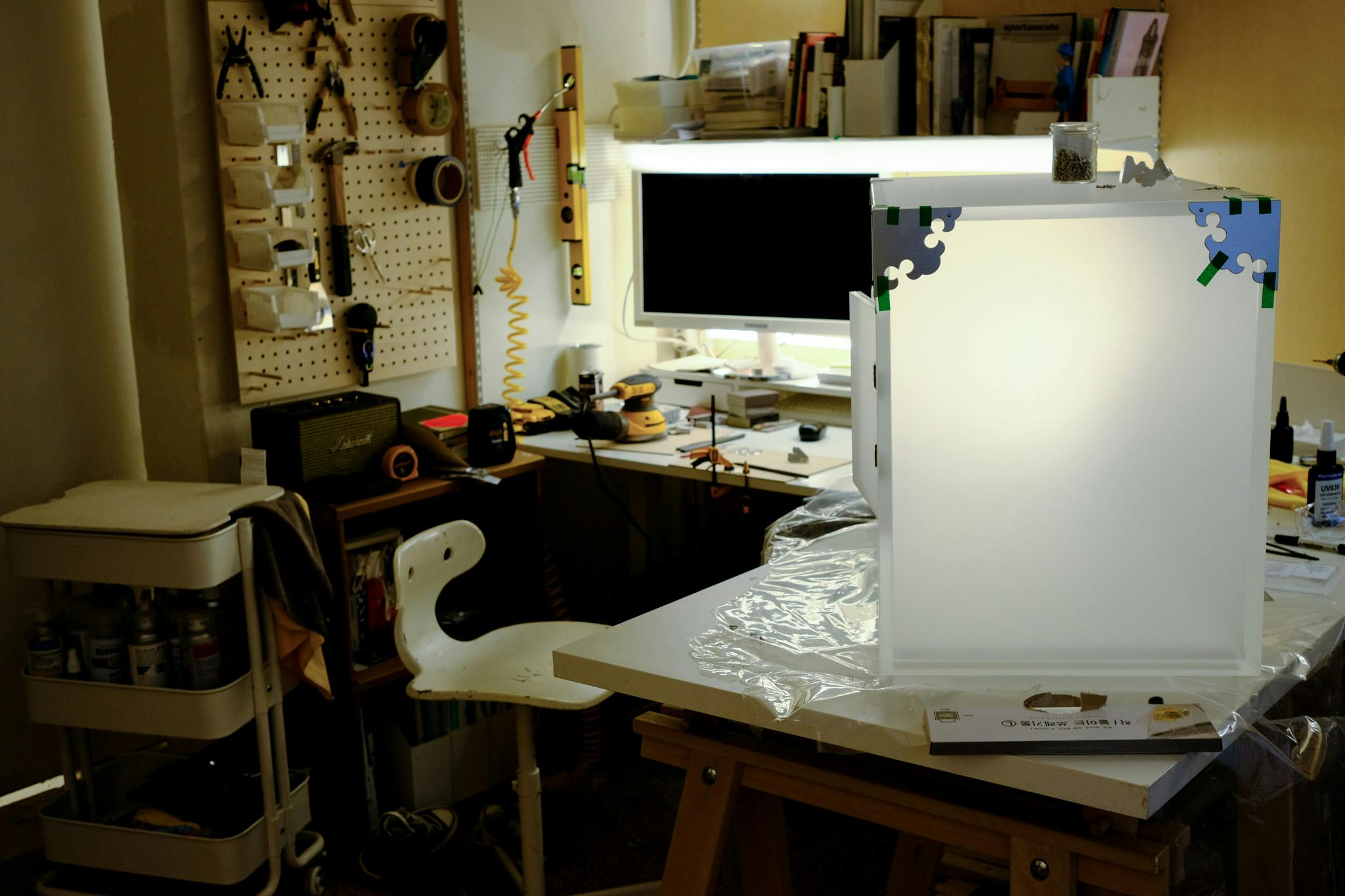
Did you study or make art while you were in high school?
고등학교 때 공부를 하거나 미술을 했나요?
My father and all of my family did art, so I have been introduced to expressing myself artistically in an organic way since I was young. In high school, I wanted to study system design, so I was more focused on math and science, but one day, I read an article about Victor Papanek, who I really admire now, in the newspaper. I thought, “How do I become like him?” and I thought the answer was going to art school. So, I started art again in my third year of high school.
저희 아빠랑 가족이 다 미술을 했었어요. 그래서 자연스럽게 미술을 되게 오랫동안 해왔었고 저는 원래는 시스템 디자인을 되게 하고 싶었어요. 그래서 이과를 갔었는데 어쩌다가 신문에서 제가 너무 존경하는 디자이너를 보게 됐어요. 빅터 파파넥이라는 어떤 건축가이자 디자이너 분이 있는데 그분을 보고 ‘이렇게 되려면 어떻게 해야 되지?’ 했는데 미대를 가면 되겠더라고요. 그래서 고등학교 3학년 때 다시 미술을 시작하게 됐어요
Did you ever help your parents with any of the art they were making when you were kid?
어렸을 때 부모님이 만드시던 예술 작품을 도와주신 적이 있나요?
My dad runs the art academy where students prepare their entrance portfolio for art schools in Korea. When I was young, I would go there after school and practice drawing and sketching with my older sisters. My father also made me do a lot of imitations of famous watercolour paintings.
저희 아버지가 입시미술학원 원장 선생님이셨어요. 그래서 어렸을 때부터 학교 끝나면 아빠 학원에 가서 언니들이랑 같이 조소도 하고 석고상도 그리고, 또 아빠가 유명한 수채화 모작을 많이 시켰어요 항상.
So he made you practice a lot.
그래서 연습을 많이 시키셨어요.
I think he probably didn’t want to be bothered (laughs), so he gave me a book and made me draw.
아마도 아빠가 제가 귀찮게 하니까 그냥 책 던져주고 여기에서 그리고 싶은거 그려라 했던 것 같아요.
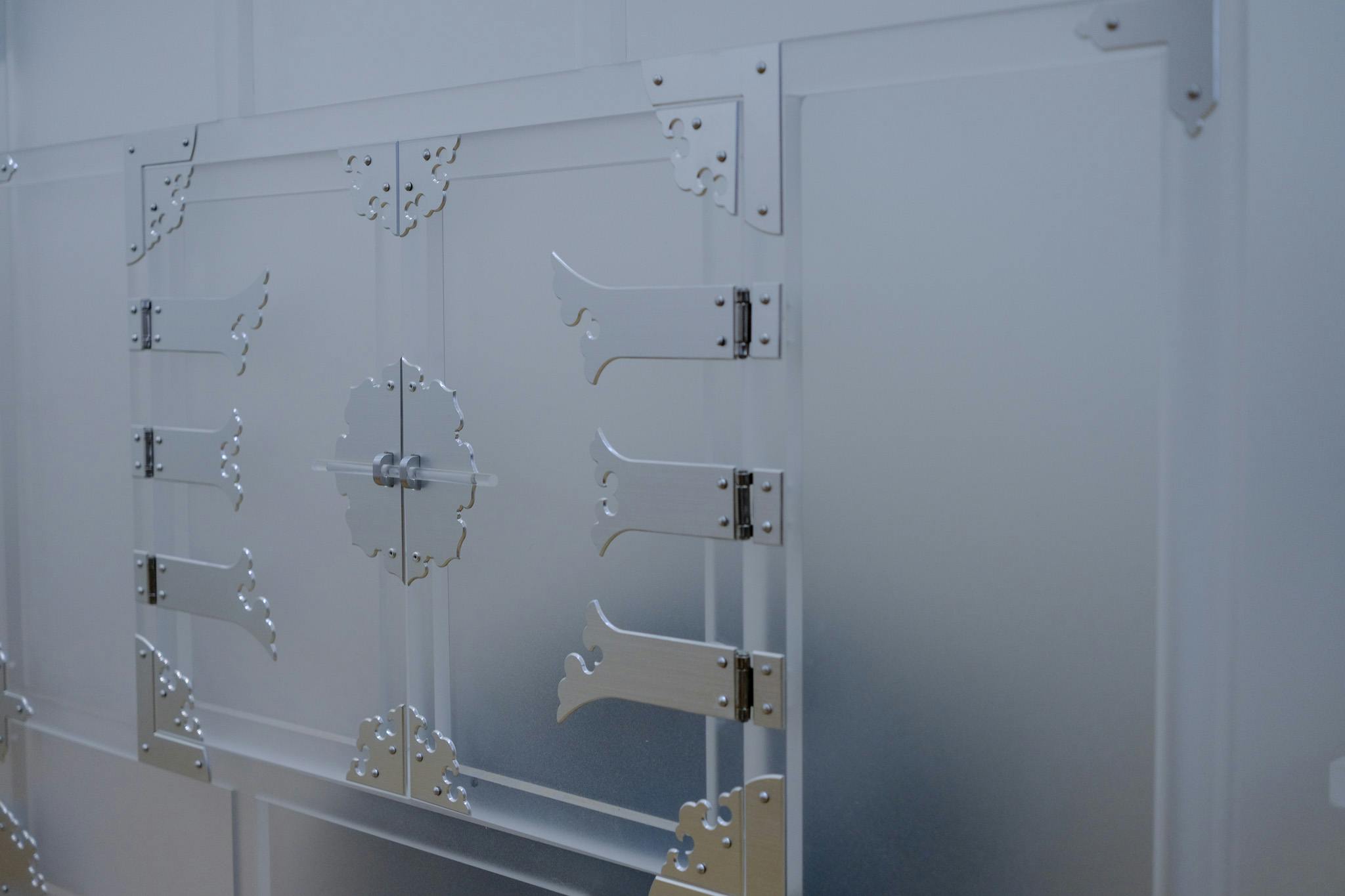
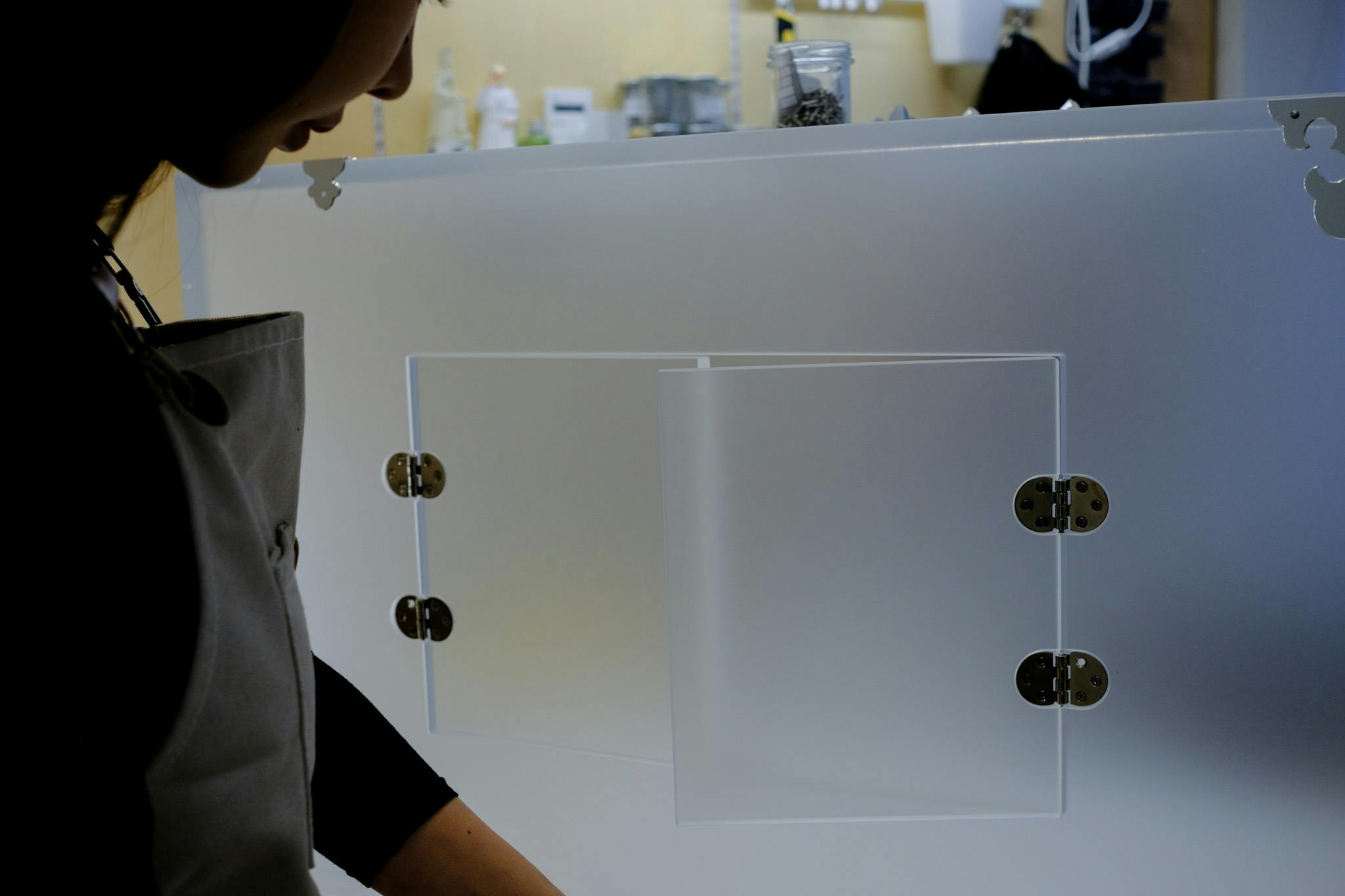
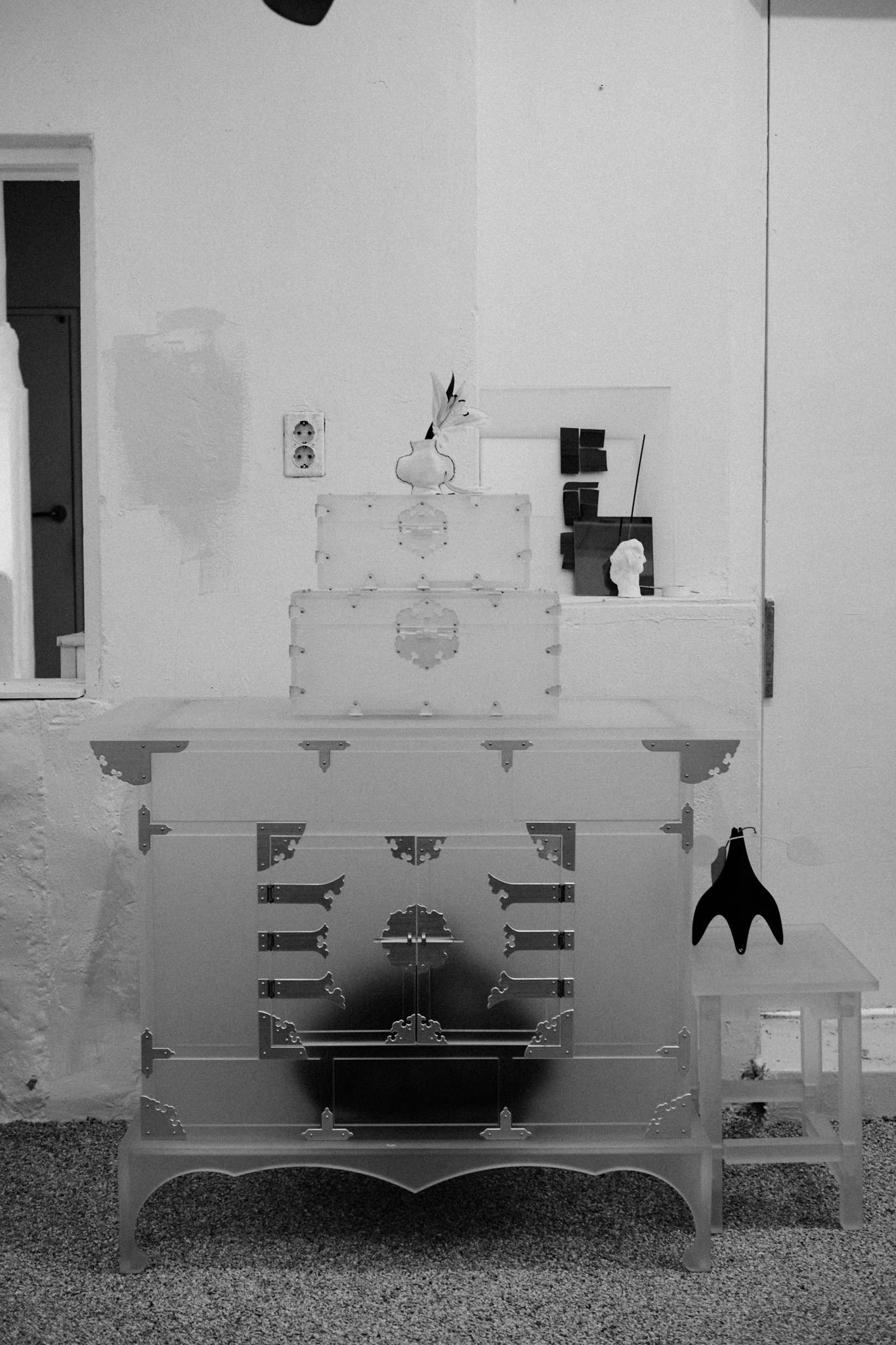
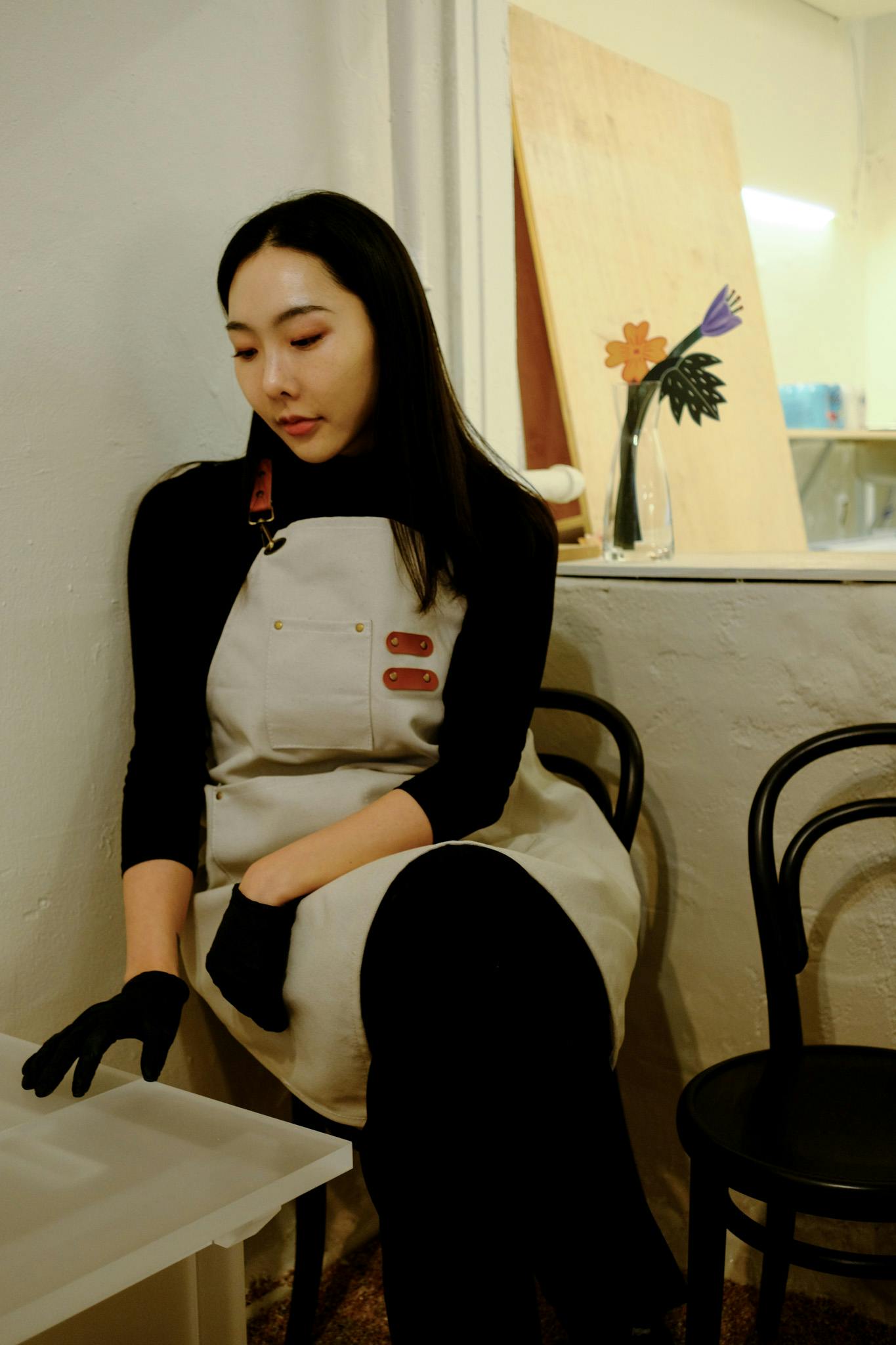
Your furniture echoes details of more historical Korean styles. Can you tell us a bit about your inspiration and how you translated these historical details into a contemporary body of work?
귀하의 가구는 보다 역사적인 한국 스타일의 세부 사항을 반영합니다. 당신의 영감에 대해 조금 말씀해 주시겠습니까? 그리고 이러한 역사적 세부 사항을 현대 작품으로 어떻게 번역했는지 말씀해 주시겠습니까?
They are inspired by furniture from the Joseon Dynasty (1392–1897), which was the dynastic era right before the establishment of modern Korean society. Before Joseon, Goryeo was a Buddhist society where men and women were relatively equal. However, as Confucianism and Neo-Confucianism became dominant in the Joseon Dynasty, the social status of men and women changed. Women’s roles were restricted, and they were expected to stay at home. Women had to stay at Anbang, which is literally translated as ‘inner room’. Therefore, as a contemporary woman living in Korea, I want to talk about the furniture used in Anbang and how it should be developed and represented in contemporary society.
조선시대, 그러니까 현대사회 오기 직전 조선시대의 가구들인데 원래는 한국이 불교 사회였다가 조선시대 때 성리학 사회로 바뀌면서 이제 국가 종교가 바뀌잖아요. 유교 사상이 들어오면서 성리학이 발전을 했는데 불교 때는 남녀가 평등한 문화가 있었던 반면에 성리학이 들어오면서 남녀 구별이 생기게 됐어요. 그리고 유교가 정착하는 과정에서 남녀 차별을 만들었고 남자는 선비, 여자는 안방이라는 곳에서 안 사람, 안방 마님 이라고 하잖아요. 그래서 여성들이 방에 갇힌듯한 삶을 살았는데, 사실 지금 시대에는 우리 여성들이 안에 갇혀 사는 것도 아니고 더 이상 성별에 따라 역할을 규정짓지 않잖아요. 그래서 저는 지금 내가 동시대 한국 사람, 여성으로서 그때 당시에 그 가구들이 어떻게 남아있고 그리고 동시대에는 그게 어떻게 발전되어야 하는지에 대해서 얘기를 하고 싶었어요.
I think these pieces of furniture represent the reality of what women’s lives consisted of at the time. It consists of panels or 'walls' which form an enclosed space, and all of the decorative fixings have meanings, such as longevity. However, they are all about family or the virtue of men, and none of the decorations symbolise anything relating to women.
So, I wondered how I could transform this into a story about women. For my first work, I made shelves using only frames and decorations and removed the ‘walls' or panels, so to speak. People who see it from far away or in photos think it’s made of glass panels because there is a visible frame and decorative fixings. Still, I wanted to reverse that concept by removing the exterior panels or the ‘boundary’ that defines the inside and outside.
당시에 안방에 살던 그 여자들의 삶이 그대로 옛날 가구에 나타나 있는데 벽으로 다 폐쇄적으로 막혀 있다던지, 거기에 이런 장석들이 많이 붙어 있는데 그 의미가 여성의 에고를 상징하는 건 하나도 없고 다 가족이나 남성의 가치 중심이에요. 그래서 저는 그런 것들에 대해서 어떻게 하면 여성의 상으로 바꿀 수 있을까를 고민하다가 처음에 했던 게 프레임으로만 만든 작업이 있어요. 그게 제가 벽을 허물고 프레임 위에다 장석을 붙인건데 그게 사람들이 멀리서 봤을 때나 사진으로 봤을 때는 유리로 된 벽이 있다고 생각해요. 유리장이라고 생각하거든요. 그래서 저는 그런점을 오히려 이용해서 벽을 없앰으로써 우리가 경험하는 안과 밖에 대한 관념이나 규정을 허물어서 보여주고 싶었어요.

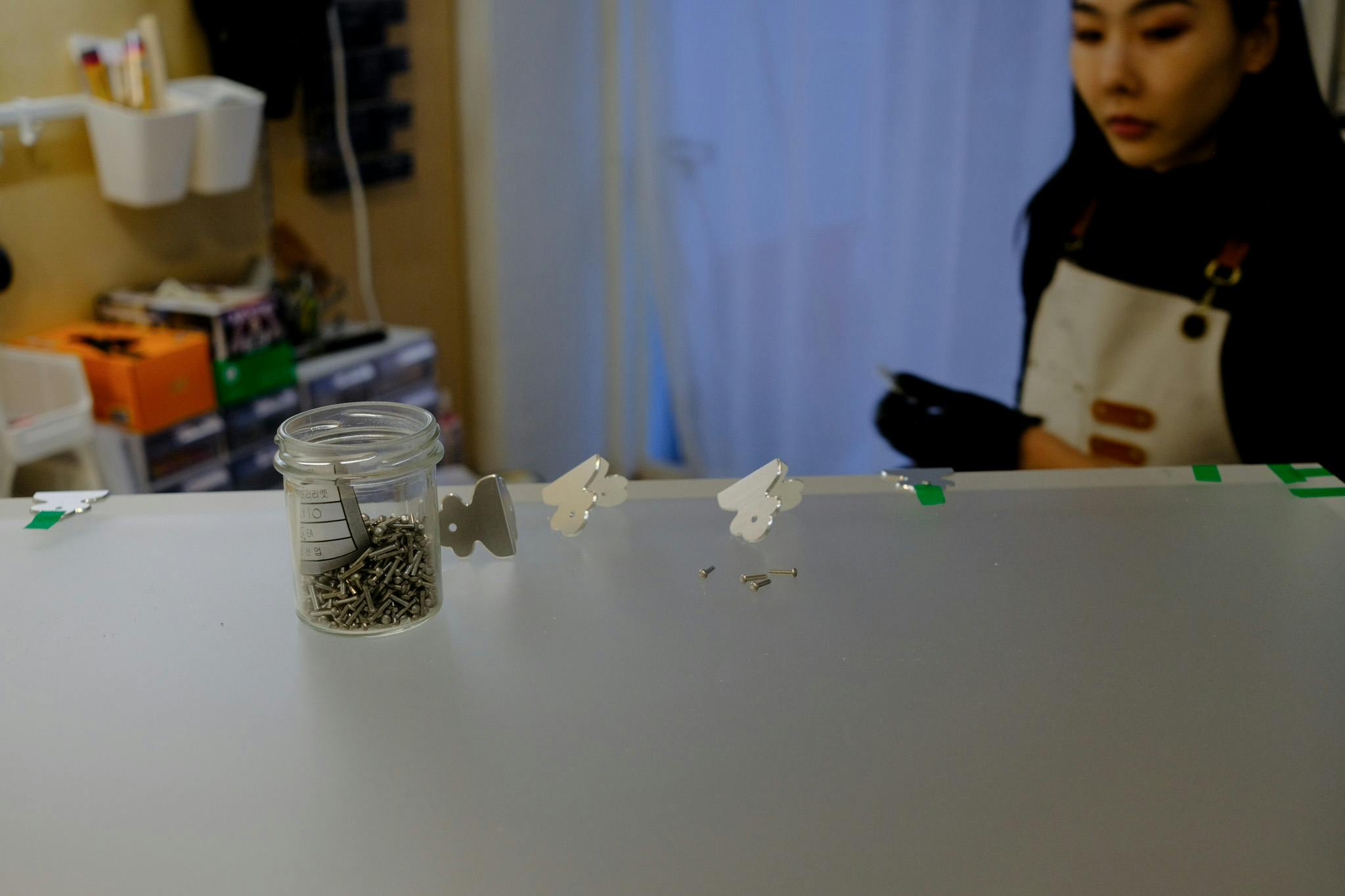
How do you feel like you're reinterpreting this heritage with your series as a contemporary woman in Korean society? What does it mean to you?
한국 사회의 현대 여성으로서 당신의 시리즈를 통해 이러한 유산을 재해석하고 있다고 생각하시나요? 그것은 당신에게 무엇을 의미합니까?
Every artist would agree that, in the end, an artist wants to talk about something only he or she can talk about. After doing a student exchange in Germany and seeing lots of wonderful things in the world, I needed to have my own identity and reflect that in my work.
I thought my keywords would be Korean, Women, and Contemporary. Korean society used to be discriminatory against women, and there was a lot of inequality. In my case, my family always supported me in finding and blooming into myself and encouraged me to become independent. I believe that is the most beautiful image of a woman in modern society. So I brought traditional furniture, which is mainly made of wood, and replaced it with more modern materials like plastic or steel. In terms of steel decorations, they can be damaged if you push them too hard, but I think it is okay to be flawed and imperfect, and still, it can stand alone.
작가들은 다 공감 하겠지만 모든 작가들이 결국 하려는 게 자기가 어떻게 살아왔고 그거를 동시대에 대입을 해서 저만 할 수 있는 얘기를 하는 거잖아요. 저도 독일에서 잠깐 교환학생을 갔다 온 경험이 있는데 그때 많은 문화를 보고 와서 생각을 많이 했던게 다양한 세계에 멋있는 것들이 너무 많은데 그걸 다 보고 오니까 결국 진짜 저만 가진 아이덴티티를 작업에 대입을 해서 만들어야 된다고 생각을 했어요. 그게 딱 한국, 여성, 동시대 이렇게 딱 세 가지 키워드가 있었던 거 같아요. 그래서 제가 이제까지 살았던 걸 보면은 한국 사회가 좀 여성에 대해서 지금은 많이 없어졌지만 차별이 되게 심했잖아요 저희 커갈 때만 해도. 그런데 저는 그래도 상대적으로 저희 가족들이 굉장히 저 자신이 되기를 되게 응원을 해줬었고 그래서 항상 독립적이고 좀 생활력도 강하고 그렇게 컸어요. 그래서 그게 저는 지금 현대에서 가장 아름다운 여성상이라고 생각을 해요. 그래서 옛날에 나무로 만들어졌던 전통 가구를 현대에서 가장 많이 쓰이는 재료인 스틸로 시작을 했죠. 그리고 그거를 통해서 좀 이게 장석이 그냥 장석끼리 달려가지고 서 있거든요. 그런데 얘를 누르면 좀 망가질 수도 있어요. 그래서 저는 그거를 통해서 조금 여리고 조금 불완전할지라도 혼자 자립적으로 서 있는 그런 여성상 같은 것들을 좀 표현하고 싶어요.
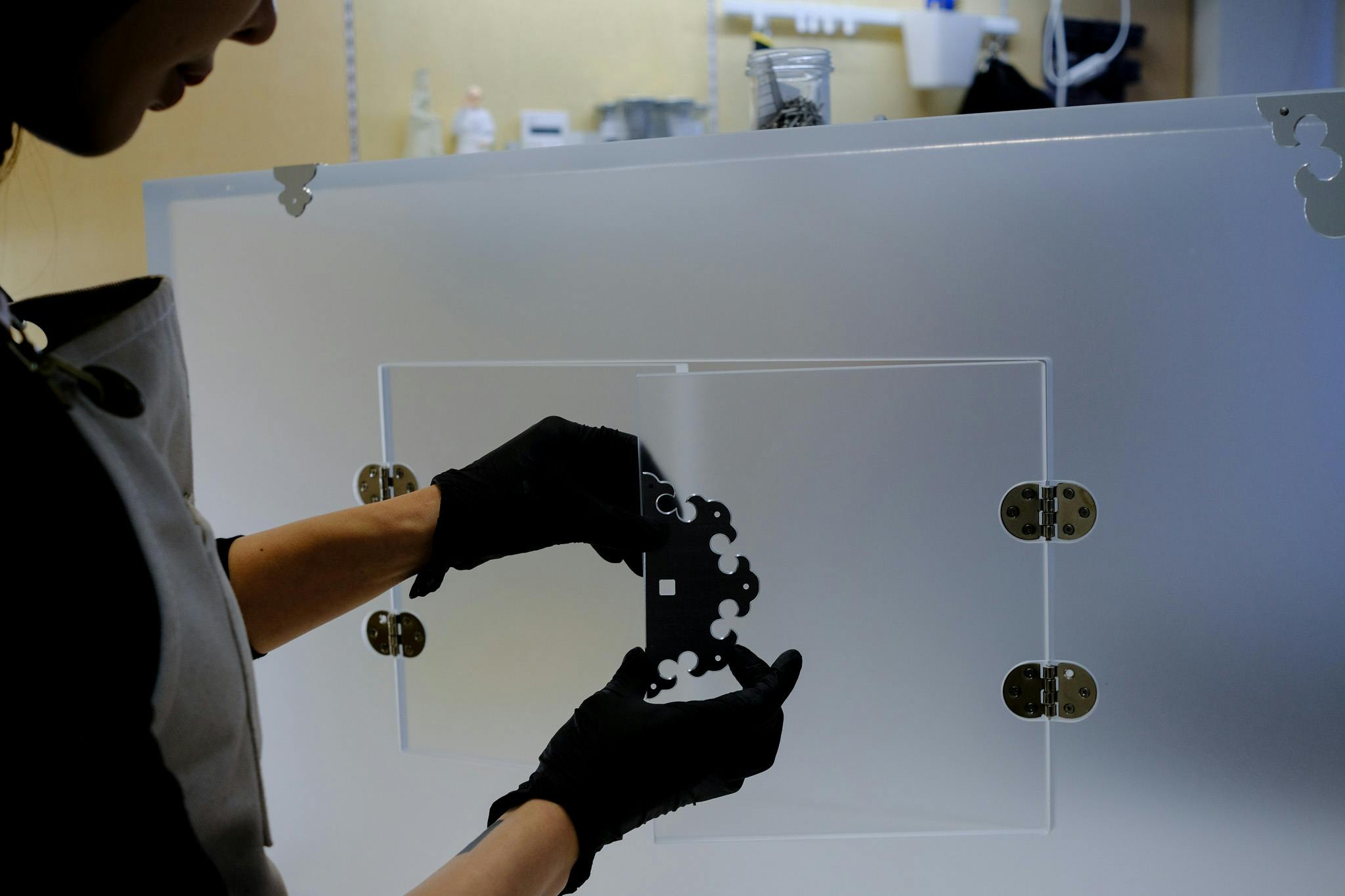
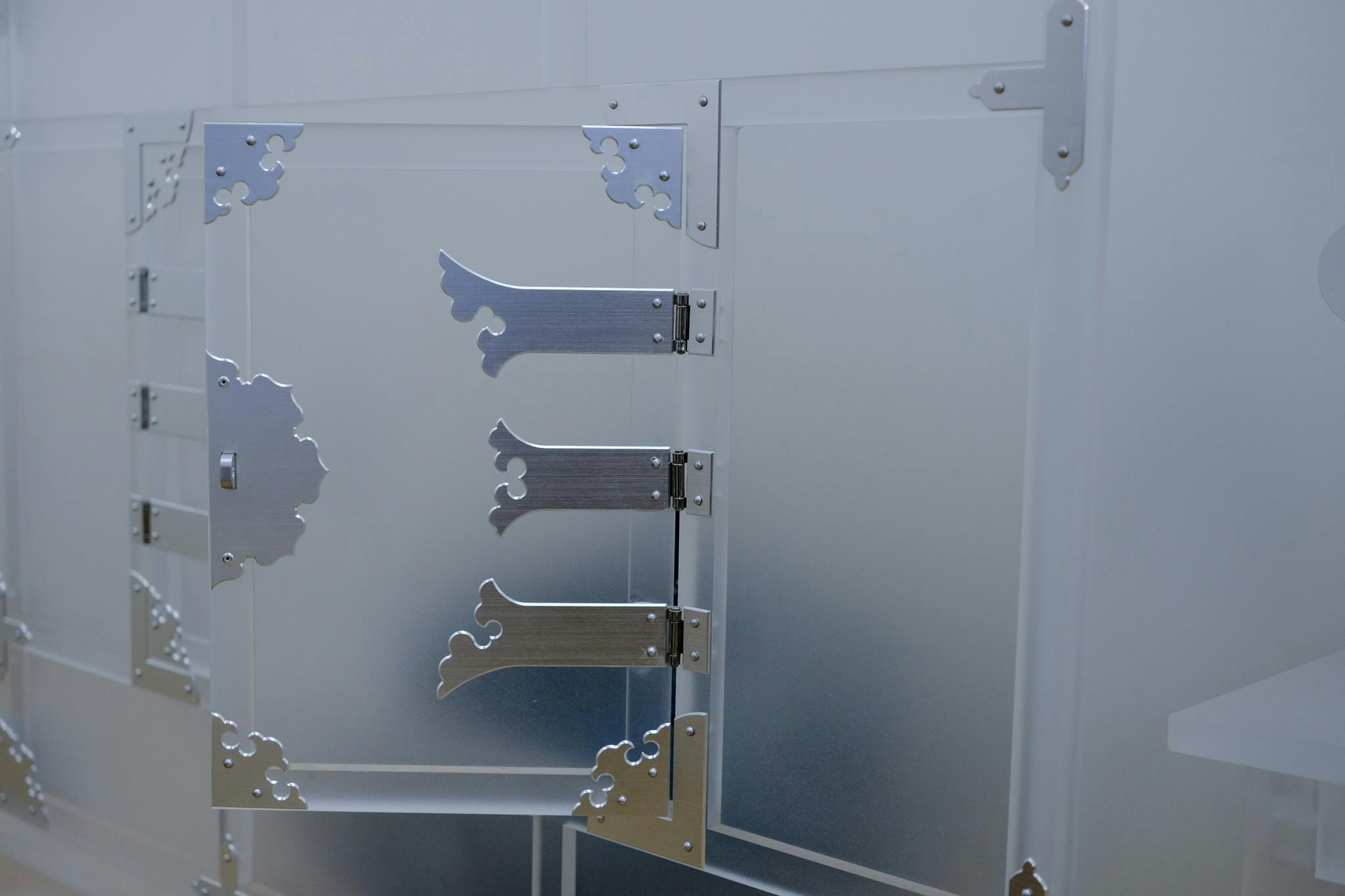
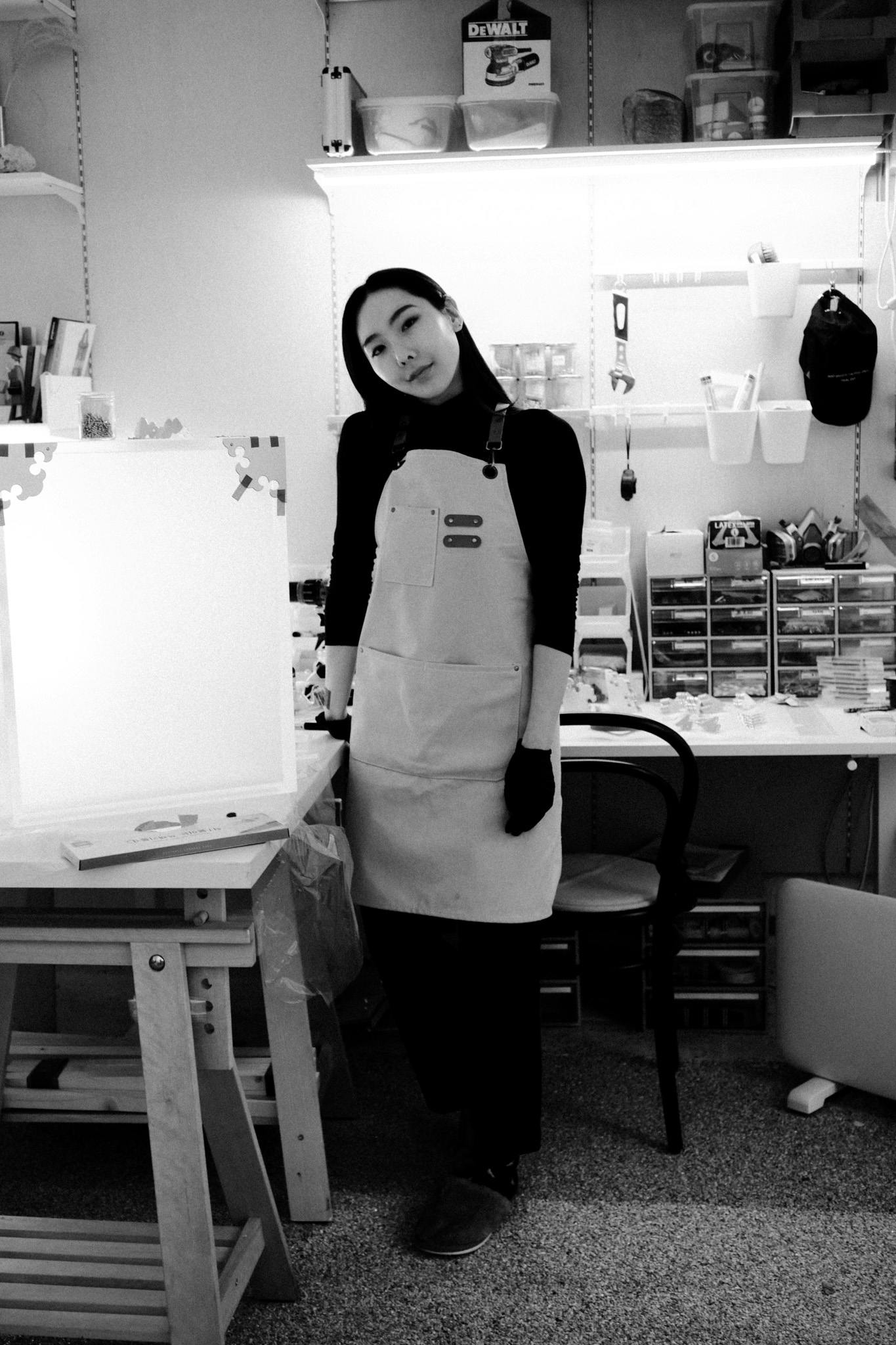

I am curious: the original Joseon Dynasty decorations that ‘represented men’ did they have distinctive features or shapes?
'남자를 대표하는' 조선시대 장식에는 독특한 특징이나 형태가 있었는지 궁금합니다.
There are various kinds of patterns; for example, there are flower patterns as well as bat patterns, which translates to ‘longevity’, and more, which often means prosperity, fecundity, etc.
되게 여러 가지 무늬가 있어요. 예를 들어 얘는 꽃무니 그리고 박쥐는 또 박쥐문이라고 해서 장수를 상징한다든지. 한국이 되게 집단주의 였잖아요 그래서 가족의 번영 그리고 다산, 장수 등이 있어요.
Did you create new symbols to represent women in this portrait of society in your pieces?
이 사회의 초상에서 여성을 대표하는 새로운 상징을 작품에 창조하셨나요?
I reference traditional patterns and create new patterns, but not entirely different, to show a clue that I adopted traditional furniture.
What made you decide to start filling the ‘walls’ in with transparent material? For functionality?
투명한 재료로 '벽'을 채우기로 결정한 이유는 무엇입니까? 기능성을 위해서?
My first work was more focused on gender themes, but my second series is more about my personal story.
There are certainly some parts that overlap, but the series with acrylic material is more focused on me and my personal memory. In Korean, when we say remembering the past or looking back on memories, we use expressions like “take out memories” as if the memory is in a box, and we open the box and take it out. Personally, I think of myself as a nostalgic person who finds herself in daydreams of “The good old days.”
But these days everyone is expected to be productive, always preparing for the future otherwise you’ll be considered lazy and falling behind. I was always thinking about that, but at one point, I decided to assume my personality was different from this mindset and embrace that in my work.
I tried to express my nostalgic sensibility, so the series is called ‘White Nostalgia.’ The meaning of nostalgia is linked to a negative image of missing memories and longing for the past, but I wanted to find a more positive angle to it. Also, ‘white’ refers to white lies or lies we tell for others' sake rather than for one’s own good. I wanted to take that ironic meaning of white to the word ‘nostalgic’.
처음 작업은 제가 그런 젠더적인 부분을 강조하려고 만든 작업이라면 여기서 아크릴 작업으로 넘어오면서 조금 더 개인적인 서사에 집중을 했어요. 과거를 얘기할때 우리가 어떤 추억을 꺼내본다 이렇게 얘기를 하잖아요. 우리는 어떤 과거에 내가 소중한 부분에 대해서 얘기할 때 외국도 그런지 잘 모르겠지만 우리는 그걸 어떤 함에 담겨 있는 모습으로 표현하거든요. 그래서 저는 되게 과거 지향적인 사람인 것 같아요. 항상 침대에 누워서 옛날에 좋았는데 생각하는 그런 주의였던 것 같은데 요즘 시대에는 다 내가 뭔가를 소비하고 생산하지 않으면 게으른 사람이라고 취급을 받고 항상 미래를 준비하지 않으면, 그러니까 미래지향적인 사람이 아니면 현대 사회에서 굉장히 도태되고 부정적인 의미로 항상 읽히는 것 같더라고요. 제가 항상 그런 생각을 은연 중에 하고 있다가 나의 과거지향적인 어떤 부분을 좀 더 인정하고 더 자세히 받아들이고 싶어서 시작한 작업이에요.
이름이 화이트 노스탤지어 시리즈인데, 우리가 노스탤지어라고 하면은 향수병이라고해서 내가 과거에 머물렀던 곳에 대해 잊지 못하는 병적인 증상을 나타내잖아요, 근데 저는 오히려 그거에 대한 긍정적인 의미를 찾고 싶었고 화이트라는 색을 부여를 한 건 하얀 거짓말이라고 하면 거짓말이란 거에서 하얀이라는 색깔이 부여가 되면 조금 더 아이러니하게 상대방을 위해서 하는 말이 되잖아요. 그래서 저는 오히려 그 노스탤지어라는 단어에 하얀색의 그 기능을 빌어 오고 싶었어요. 그래서 지금 지금 하고 있는 작업들이 다 하얀 이유가 그거에요.

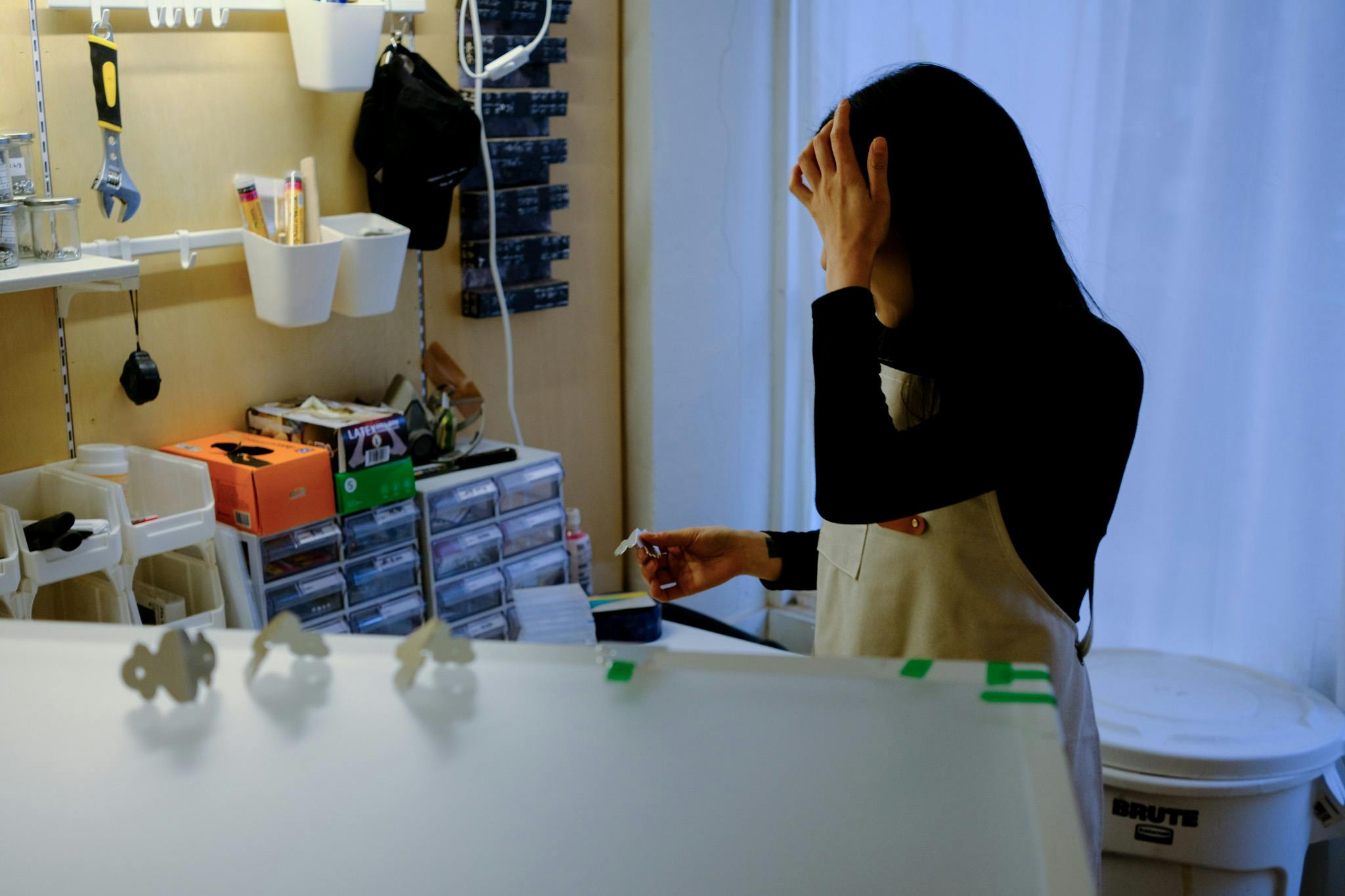
I haven't met too many women who work in design in Korea, and I'm really curious how you feel it is now in the contemporary design scene.
For instance, I'm American but live in Paris, France. In New York, women have a lot more equality in the workplace than in France (even though they will tell you the opposite). Still, as a woman working, I see that women are not given the same opportunities that men are given here. In most of the museums, it's something like ninety percent male artists. Also, the galleries represent more or less ninety percent men. It is still also difficult in the United States, but in France, it is really unequal.
How is it for women in design in Korea? Do you see things changing? What would you like to see more of?
한국에서는 디자인 분야에서 일하는 여성을 많이 만나본 적이 없는데, 지금 현대 디자인 현장에서는 어떤 느낌을 갖고 계시는지 정말 궁금합니다.
예를 들어, 저는 미국인이지만 프랑스 파리에 살고 있습니다. 뉴욕의 여성들은 직장에서 프랑스보다 훨씬 더 평등합니다. (물론 여성들은 그 반대라고 말하겠지만) 그럼에도 불구하고 일하는 여성으로서 이곳에서는 남성들에게 주어지는 기회가 여성에게는 주어지지 않는다는 것을 깨달았습니다. 대부분의 박물관에서는 90% 정도가 남성 예술가입니다. 또한 갤러리는 대략 90% 정도의 남성을 대표합니다. 미국에서도 여전히 어려운데 프랑스에서는 정말 불평등해요.
한국 여성 디자인계는 어떤가요? 상황이 변하는 게 보이나요? 무엇을 더 보고 싶나요?
The reason why I talked about gender issues in my first series is also related to that. There are only four furniture design programs in Korea, and you’ll notice many more female students. But in the professional field, ninety percent of the artists are men, and they have their own community that women can not get into.
Furniture work indeed requires a lot of physical strength, but it is also certain that there is an inequality. I don’t make the assumption that male artists intend to discriminate against or exclude female artists; they just followed the path that already existed for them and didn’t refuse to take advantage of their privilege. So, I feel obliged to work harder and pave the way for other women artists. I think it is becoming better, though. There are so many talented women both in Korea and internationally; it is impossible to ignore.
제가 첫 작품으로 젠더적인 얘기를 한 이유도 한국에 가구 학과가 네 개 밖에 없어요. 그 네 개 중에서도 저희 학과가 제일 유명한데 그 안에서도 여성 비율이 훨씬 많은데도 불구하고 졸업을 하고 나면 거의 90% 이상이 다 남자 작가들이었고 그리고 그 내부에서도 남자 작가들만의 커뮤니티가 있어서 여성 작가가 거기 낄 자리가 없었어요. 그리고 가구는 특성이 굉장히 무겁고 힘이 많이 들잖아요. 그런 부분에 있어서 여성으로서 물리적인 힘도 굉장히 많이 드는 것도 사실이고 그래서 그런 부분에 있어서 되게 저도 나쁘게 말하면 피해의식이고 정당하게 얘기하자면 확실한 불평등이 존재했다고 봐요. 근데 어쨌거나 불평등은 불평등이고 제가 생각하기에 그때 당시에 그 풀에 있는 남자들이 일부러 차별하기 위해서 한 건 아니라고 생각을 해요. 이미 그렇게 이어져 나왔던 그 어떤 풀에서 그들은 그냥 혜택을 받을 수 있으면 당연히 받겠죠. 근데 여성이 아니기 때문에 그 외적인 부분에 대해서 생각을 못한다고 생각을 하는데 어쨌거나 가고 싶은 길이 이쪽이면 제가 좀 더 나중에 잘 해서 열심히 해가지고 그 이후에 여성들의 어떤 길들을 제가 좀 더 넓혀야겠다는 그런 의무감도 있고, 최근에는 진짜 한국도 외국도 그렇지만 워낙 너무 잘하는 여성 작가들이 진짜 많아요. 그래가지고 요즘에는 오히려 그런 게 많이 없어진 거 같아요
Are the women in the local design scene building a community for themselves?
지역 디자인 현장의 여성들이 스스로 커뮤니티를 구축하고 있습니까?
I recently joined the female artist community called ‘Louise The Women’ built by young female artists in Korea. It is really great that we can start collaborations and help each other, even with small conversations or jokes and be able to find someone you can get along with.
여성 작가들이 이제까지 굉장히 개인적으로 숨어서 작업을 했다면 최근에 들어서 제가 루이스더우먼이라는 또 한국의 신진 여성 작가들을 위주로 하고 있는 커뮤니티가 있는데 거기 이제 저도 들어가서 작업을 하고 있어요.
거기서 확실히 어떤 커뮤니티를 이루면서 하면서 정말 좋은 점은 그냥 작은 농담이라도 주고받다가 서로 마음이 맞는 부분이 있으면 서로가 하고 있는 분야를 넘어서 또 새로운 작업을 같이 연대해서 하기도 하고 그런 게 너무 좋은 것 같은데 그런 게 있다는 걸 좀 알려주시면 좋을 것 같아요.

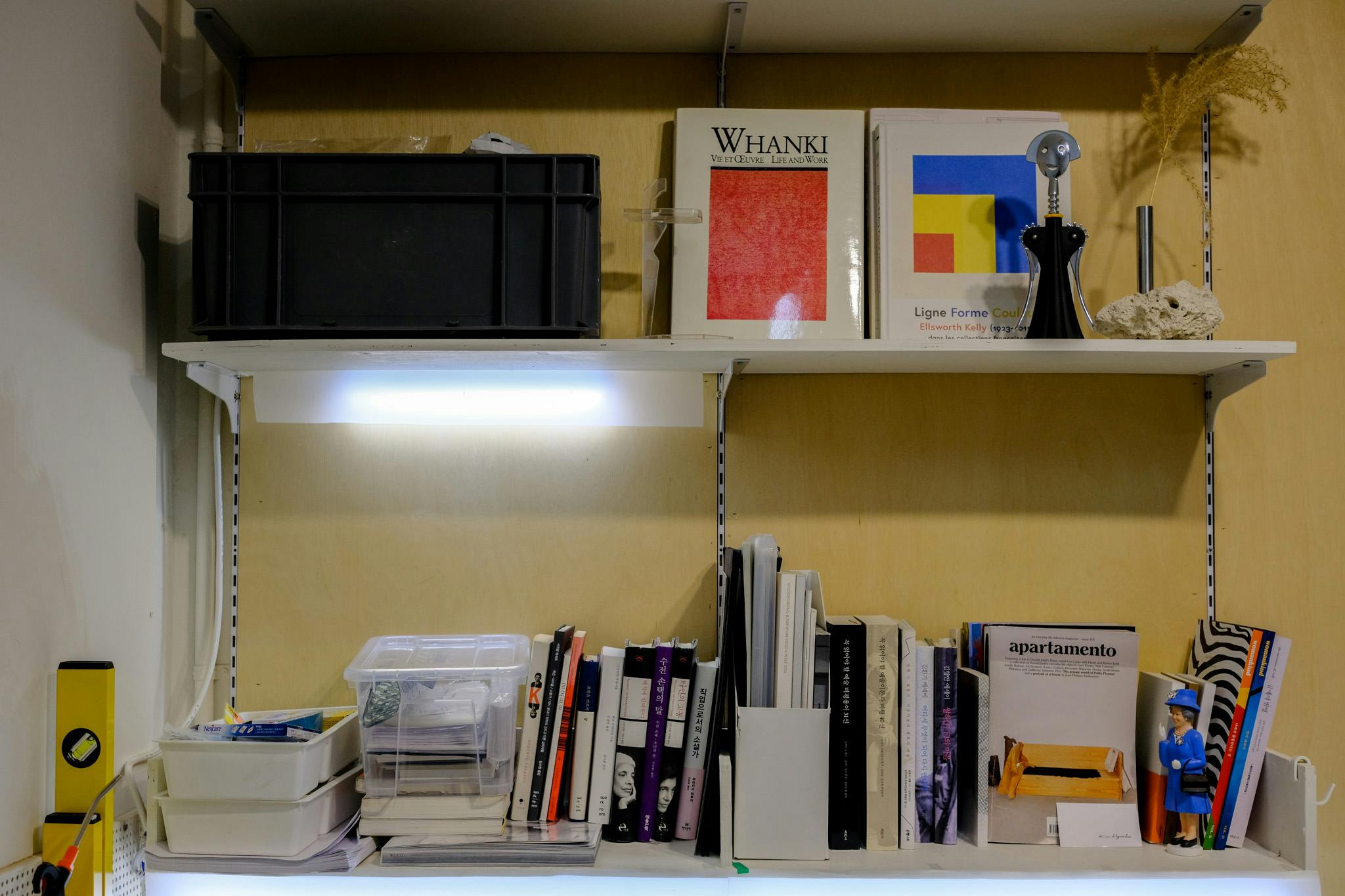
How would you describe the contemporary Korean design scene? What do you think makes it special here compared to other places? Something very creative is happening here. It feels like Korean designers are redefining what Korean design is. How would you describe the evolution of Korean design?
현대 한국 디자인 현장을 어떻게 설명하시겠습니까? 다른 곳에 비해 이곳이 특별한 이유는 무엇이라고 생각하시나요? 여기서 아주 창의적인 일이 일어나고 있는 것 같습니다. 한국 디자이너들이 한국 디자인을 재정의하고 있는 것 같아요. 한국 디자인의 발전을 어떻게 설명하시겠습니까?
That’s a hard question. Yes, not only in design but in many facets of Korean creative culture, such as K-Pop, are getting a lot of global attention. I think the reason is that everything is hybrid in Korea. Europe, for example, had power, so it was possible for them to protect their culture and legacy as well as be able to record it.
With that, they have a strong tradition and have stably developed over the centuries. In contrast, Korea has always been affected by neighbouring countries. Geographically, survival was a priority for us, and our culture is connected to survival as well. We adopt new things and abandon them quickly if it doesn’t work, which makes a hybrid culture with tradition. Especially in our generation, everything is mixed with different cultures, so this hybrid approach comes very naturally, and that makes us gain a lot of attention because that is the way we are. I think the Korean design identity is like a mutant that keeps changing and adopting new things.
정말 어려운 질문인데, 저는 사실 한국이 지금 디자인뿐만 아니라 케이팝도 그렇고 문화 전반적인 부분에서 굉장히 부흥을 많이 하고 외국에서도 주목을 되게 많이 하고 있잖아요. 저는 그것의 가장 큰 이유가 한국은 뭐든지 약간 하이브리드 되어있어요. 문화가 예를 들어 유럽에 가면은 막 크리스마스 마켓도 있고 그러니까 그들이 이제까지 항상 강대국이었기 때문에 자기네 나라의 문화를 지킬 수가 있었고 기록을 할 수가 있었거든요. 그렇기 때문에 그들은 전통이라는 게 너무 견고하고 그래서 거기서 문화가 발전할 때 되게 이게 온건하게 발전했다고 해야 되나? 근데 한국은 이제까지 중국에서 치고 오고 일본에서 치고 오고 하면서 뭔가 반도의 특성상 자기 문화를 지키기엔 너무 생존이 중요했었고 그렇기 때문에 문화 자체가 되게 생존과 직결되는 거 같아요. 그래서 기존에 있던게 생존에 안맞으면 없애고 새로운 거 짓고, 그러면서도 결국 또 남아 있는 그 어떤 전통적인 부분이 있잖아요. 그런것들이 되게 하이브리드 된 것 같은데 사실 지금 세대 자체가 동서양을 막론하고 뭐든지 어떻게 될지 모르는, 그리고 너무 많은 문화가 문화와 그런 것들이 섞여 있어서 그냥 하이브리드는 게 너무 당연시 되는 시점이기 때문에 한국의 원래 이런 문화 자체가 굉장히 주목을 많이 받을 수 있다고 생각해요. 그래서 저는 사실 한국 전통이라는게 우리가 생각하는 대단한거라기 보다는 이제까지 생존에 직결돼 오면서 계속 뭔가 새롭게 또 바뀌고 약간 돌연변이 같은 그런 성질을 갖고 있는 게 한국의 디자인 아이덴티티인 것 같아요.
























